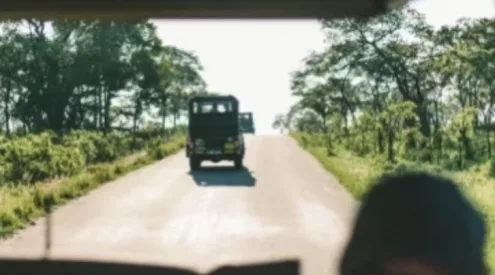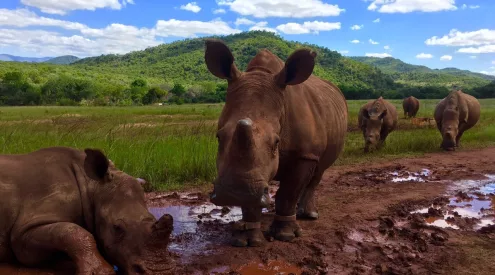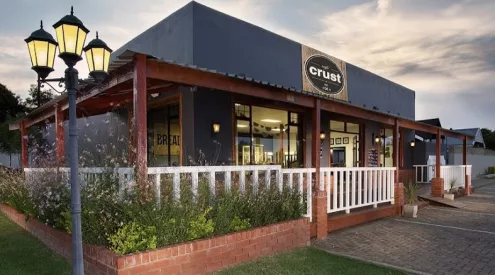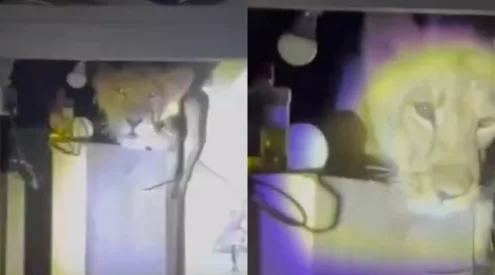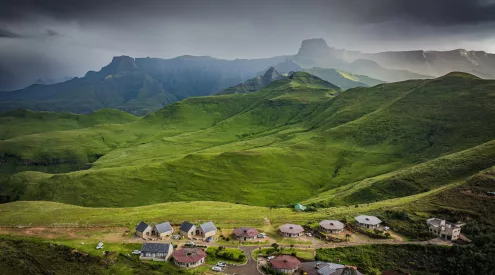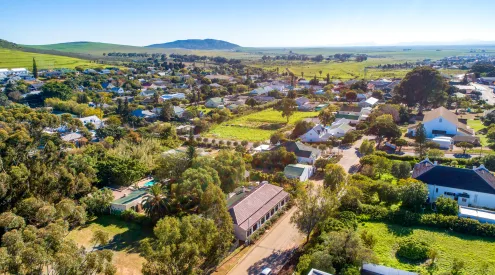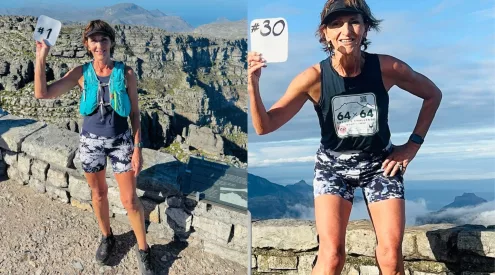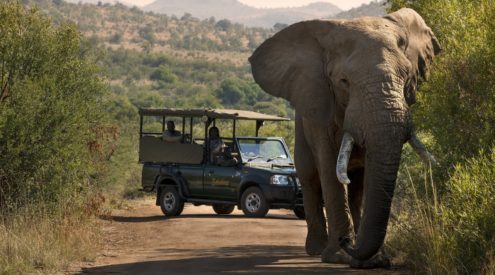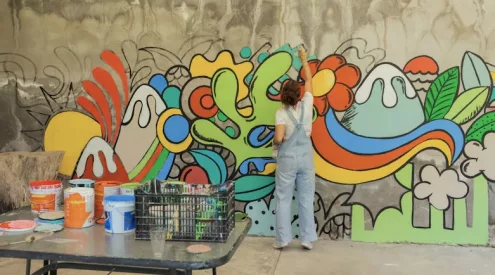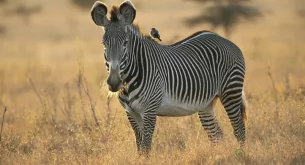“For f-k’s sake, Wayne, leave the bloody beads alone and get back in the truck,” yelled the young woman to her partner as we waited in our Land Cruiser, engine idling, behind theirs.
Only an Australian would address her significant other that way in front of a couple of hundred strangers, but everyone in the convoy was waiting for Wayne and if his missus didn’t knock his block off, then one of us would if he didn’t do as he was told.
Time equals money in East Africa’s national parks and no one wanted to waste a minute of this day. We were, after all, perched on the very edge of paradise, and all Wayne could think of was souvenir shopping.
Eventually we started moving, the agonizing anticipation made even worse as the black dots ahead of us started taking shape. “Buffalo,” said Godwin, our guide from Maasai Wanderings (www.maasaiwanderings.com).
We’d actually almost run into some buffalo on our drive from Rhino Lodge, where we’d stayed the night before, on the rim of Tanzania’s Ngorongoro Caldera (it’s not a crater) en route to the descent road.
Rhino Lodge is clean and comfortable and if you aren’t set up to camp and don’t want to shell out even more money than you have to in order to be here, then it’s your best bet for roofed accommodation the night before your descent to the caldera floor.
So, just five minutes into our descent (it takes about 20 minutes to get down the wall into the bowl below) we’re already stopping, again, to look at buffalo. Part of me wanted to urge Godwin onwards, to catch up with the bead-less Wayne and co, but I took a breath.
What, after all, were we here for? To look at animals, right? The convoy of Land Cruisers had left us in their dust, as they raced for the floor of the caldera. Here was something I’d never seen, though… a cape buffalo up above me.
The descent road is cut into the side of the caldera’s rim wall and this herd was grazing up the slope from us. I’d seen plenty of buffalo in my life… thousands for sure, probably hundreds of thousands, but I’d never looked ‘up’ at one, from below.
And here, I suddenly realised, was what could be so special about this place.
It’s Africa, Jim, but not as most of us familiar with Southern Africa know it.
Below us, as we trundled again down the descent road, we entered a huge natural stadium. You can easily see from one side of the caldera to the other. The walls, which are always in sight, are clad with thick bush, but from a distance they look smooth.
The floor, however, apart from a straggly string of riverine vegetation that follows a couple of watercourses, is as flat and as open as a billiard table – and at this time of year, as green.
I had buffalo above me and everything else below me. It wasn’t going anywhere. We only had a day in the caldera, but who needed to rush?
Not Godwin.
By hanging back from the rest of the vehicles that had been queuing for entry into the Caldera, Godwin was able to watch where they went. All of them turned right at the ‘T- junction at the bottom of the descent road, and they were disappearing fast across the table top.
“I think we’ll turn left.”
Godwin was my kind of guide. Instead of being content to switch on his radio, listen for sightings and chase other guides around the Caldera, he wanted to go find his own game.
“One thing I hate,” he confided to Mrs Blog and me, “is when one of my clients spots an animal before me. This means I haven’t been doing my job.”
Interesting, I thought. Part of the briefing for most of the game drives I’ve ever been on with someone else driving is for the guide to inevitably conclude with a line about how because he or she has to watch the road, and because we tourists are often placed on seats higher than the guide that we should also keep an eye out for animals and call out if we saw anything.
As much as I admired Godwin’s professional dedication, I like spotting animals, and I like spotting them first. How hard, I wondered, could it be to spot game when there was good light, and no trees or other cover to hide them?
Bloody hard, as Wayne’s girlfriend would have said.
“Oh, there’s a lion,” Godwin said casually.
And so there was, a big, black-maned lion lying out in the grass, about a hundred metres off to our left. He raised his head for a couple of seconds then flopped backed down again. I’d been standing in the back of the Cruiser, my head and shoulders out of the hatch, scanning like mad. Mrs Blog was looking, too, and she has very good eyes for game spotting. Neither of us saw the lion.
It was in the open, in grass that wasn’t even all that long, but we were so out of our zone when it came to game viewing (most of our time is spent in the bushveld of southern Africa) that we hadn’t even thought to look in the most obvious places.
“Hyena,” Godwin said.
Same thing, again… it was out in the open, but we didn’t spot it. What made the hyena sighting even more amazing (aside from us missing it) was that it was close to herd of wildebeest – in fact, the biggest herd of wildebeest I’d ever seen in my life. There were probably about 200 animals in this grouping.
“This is nothing,” Godwin said, when I remarked on my personal-best wildebeest sighting. “We’ll see many more in the Serengeti.”
Time and again over the next few days, in the caldera today and later on the open plains of the Serengeti, we would see predators – lions, cheetah and hyena – strolling along or otherwise going about their business within a strong-armed stone’s throw of their prey.
When there is no cover, there is no pretence, it seemed, and little chance for ambush hunting. Predator and prey in the caldera seemed to know each other’s limitations perfectly. Why should a zebra take flight at the sight of a lion (as I’ve seen them do in bushier parts of Africa at the first glimpse of danger), if it knows exactly how much distance it needs to outrun that lion it’s been watching all day?
“Give me five,” said Godwin.
I dutifully slapped his palm, and asked, “Why?”
“Cheetah. Two of them.”
And so there were, way off, in the grass, occasionally raising a head to look at us, and a pair of Grant’s gazelles grazing not far from where they lay. Apparently there are only three or four cheetah in the caldera and Godwin, by taking the route less traveled, had found two of them, all by himself.
And so it went on… more lion, black rhino (a lovely sighting of a mother and calf walking across the tabletop towards us), elephant, zebra, Cox’s hartebeest, jackals, Thomson’s gazelle, more Grant’s, etc etc etc. At the salt lake in the middle of the caldera we watched thousands of flamingo shimmering pink in the hot midday sun and then caught up with yet more snoozing lions.
Godwin drove to a picnic site for lunch and advised us to eat our lunch (packed in cardboard boxes) inside the vehicle. It soon became apparent that his advice was good. Scores of yellow-billed kits circled vulture-like above the game viewing vehicles and with scary regularity one of the raptors would dive-bomb a tourist who had either ignored or not been given the warning. With an ear-piercing shriek another chicken leg was carried aloft.
After lunch we drove around looking for leopard in the aforementioned straggly riverine lines, and nosed up into the foothills of the caldera wall, but didn’t find any more spotted cats. That was kind of OK, as we still had three days to kill in the Serengeti.
As the shadows lengthened we reluctantly started the climb up the steep and winding crater wall.
For nearly twelve hours we’d seen non-stop animals, all around us. There wasn’t a single second, I don’t think, when we weren’t looking at something. It was sensory overload, but it was all real.
If the Ngorongoro Crater/caldera was a private game reserve, one would say it was overstocked – unnatural and cruel, even – with too many animals crammed into such a small space (and with no trees for them to stand under in the searing heat!).
At times it reminded me of a huge Disney-like collection of animals; a massive outdoor zoo. But it wasn’t. It was, as I said before, all real, all natural.
Some of the animals in the caldera come and go in seasonal migrations, but others live their whole lives there – not because man put them there, or farmed them there, but because that’s what they’ve always done. Just because the place was so totally out of my limited frame of reference of Africa didn’t mean it wasn’t right.
Would I recommend it? Would I go back?
I’m not sure how to answer my own questions, having just posed them. Let’s tackle the first… If a person had never visited Africa and their proposed first stop was Ngorongoro, I might be tempted to say no, don’t do it. If your first day of game viewing was like this one, then you might be spoiled for life. Nowhere else would you see so many animals, and so many different species all in the one place, virtually at your fingertips.
If for some bizarre reason you could only spend 12 hours of your life in Africa and you wanted to see as much as possible, then knock your hypothetical self out – this is the place to visit.
If you’re a game viewing addict (as I am) or photography buff and can never get enough wildlife then go for it. Do it. Save up the money and go. It’s an experience in itself to see so much in so short a time, in such an extraordinarily scenic place.
Now for question two… would I go back?
I don’t know. I think the attraction of Ngorongoro for me was what Godwin would have called one of those photos that live only in the album of your mind. It’s the sudden realisation, even more than an image, that this is not a zoo; not an overstocked game park (only the rhino have been introduced, as the original inhabitants were all slaughtered years ago); and not a mirage. This is Africa as it once was, and as it should have stayed, a paradise teaming with all that mother nature intended.
Did you know that Ngorongoro is not actually a word, in the sense that it doesn’t mean anything?
It’s an onomatopoeic description of the sound a cow bell makes, as coined by the Maasai. Say it to yourself two or three times… it does sound like a cow bell. It’s the noise the tribesmen associated with herding of their animals into and out of the caldera, as the cows walked up and down the crater walls.
Although I’m far away as I write this, I can hear it now. I can see it. I might have to go back…

